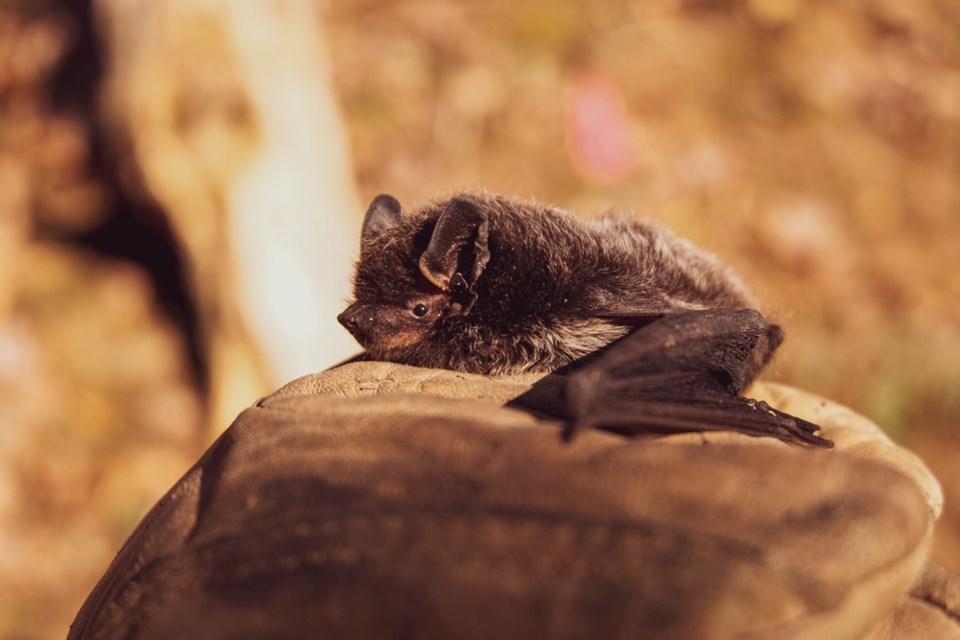Even in the face of COVID-19, bat conservation efforts in Squamish and Brackendale continued this summer.
That’s good news from a provincial perspective, according to Danielle Dagenais, who leads the BC Community Bat Project’s Metro Vancouver-Squamish efforts.
“It’s a great habitat for the bats with the forest, the river, the estuary, the rocks, so it’s just great,” she said.
In a Sept. 14 interview, Dagenais said 2020 was mostly successful. In conjunction with the Squamish River Watershed Society (SRWS) and the local Men’s Shed, the group held a bat-box-building workshop this spring before the pandemic shutdown started, resulting in 10 bat boxes for distribution to community members.
However, there were a few effects of the health crisis during the summer, as Dagenais noted that the program’s annual bat count saw some disruption as the program was unable to obtain access to some sites because of the pandemic.
This year, the program got access to 10 building sites and seven bat boxes.
However, since stepping into the role three years ago, Dagenais said there have been massive gains overall.
“When I first started, there were two roosts that I knew about in Squamish,” she said. “There are now 21 building roosts that are reported and 10 bat boxes.”
As well, there was one volunteer when she took over, but now 33 are on the list, with 24 participating this year.
Dagenais submitted the data collected to the provincial co-ordinator, Mandy Kellner, who will look for trends from across the province.
In 2020, some roosts were better off, some worse and some the same, but it’s difficult to interpret those results in a vacuum without provincial trends.
“The bats could have moved to a new location. It doesn’t mean that the population has dropped,” she said.
For example, one area has three roosts, but the program could only access one this year. While the bats may have moved to one of the nearby options, they could also have been adversely affected by fires in the area.
Even though the count is done, there are plenty of ways for the public to get involved. For a start, Dagenais said, reporting bat sightings, activity, roost sites and dead bats is key for monitoring white-nose syndrome, a fungus that has not yet been detected in B.C. and is most lethal to bats in the winter.
“If there are rock climbers or cavers that come across bats in the wintertime, we don’t want them to disturb them, but we definitely want them to report it,” she said. “We don’t know where a lot of our winter habitat is, so if we can identify these [places], we can identify our bats with white-nose syndrome in the future.”
Those looking to get a bat box, Dagenais said, should request one through the Men’s Shed rather than buying one commercially, noting that commercial ones are often poorly built. In most cases, she said, the poor construction means bats just won’t utilize them, but in rare instances, if females try to raise their young in the site but then decide to move on to a better location, they could be forced to abandon the babies.
“You always have to be cautious if you do want to add a bat box. You have to make sure that the design is proper and that you’re installing it properly,” she said. “There are some bat boxes—not many—that are poorly designed in that they can cause the bats to get overheated.
“If that happens, they need to have shade or they need to move. If their young is small, they can carry their young and they can move to a new location. If their young is really big and they can’t carry it, the females could leave and the young could die.”
As well, Dagenais collects contact information from those who build or receive bat boxes through the Men’s Shed in order to follow up. She notes that the monitoring commitment is small, just one to four hours per summer, plus one 15-minute check each in the spring and autumn.
As for local efforts, Rhonda O’Grady of the SRWS said the group was limited in its large event programming because of the pandemic, but the group was happy to support the BC Community Bat Project’s monitoring efforts.
Looking ahead, O’Grady hopes to see more bat boxes built and installed in town, especially around the estuary. While there’s a larger bat condo in that area, because the females and their pups need warmth and stick to together, the houses could be a better start.
“We’re not seeing a lot of bat action around that condo,” she said. “We put our heads together and we’re thinking we need to put some smaller bat houses around the estuary and that way, the smaller populations, once they’ve populated those little houses, will eventually hopefully move their population into the larger condo.”
Since conservation efforts in Squamish have really only picked up in recent years, education is still very much important.
To that end, the SRWS has made an education resource pack available at the library for teachers or scout leaders to have a fun session about bats with kids, as the winged backpack contains books, magazines, games, video and even a bat puppet and skeleton.
“I’ve heard through teachers that they absolutely love it and it’s been taken out quite a bit,” O’Grady said. “After they get the bat pack, they often ask for someone to come into the classroom to do a program with the kids.”
Dagenais added that homeowners discovering bats in their buildings should learn how to evict them safely in a way that does not impact the population.
For more bat resources, or to contact the program, visit www.bcbats.ca.
Those looking for more information on bats can attend the virtual Bat Matters Conference for a cost of $25. The conference, running from Sept. 28 to Oct. 9, includes eight recordings and two moderated sessions. For more, visit burkemountainnaturalists.ca/bat-matters-2020.



